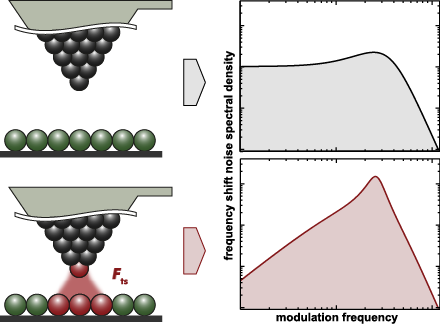Search results
Search for "detection system noise" in Full Text gives 4 result(s) in Beilstein Journal of Nanotechnology.
Noise in NC-AFM measurements with significant tip–sample interaction
Beilstein J. Nanotechnol. 2016, 7, 1885–1904, doi:10.3762/bjnano.7.181

- & Astronomy, The University of Nottingham, University Park, Nottingham NG7 2RD, UK 10.3762/bjnano.7.181 Abstract The frequency shift noise in non-contact atomic force microscopy (NC-AFM) imaging and spectroscopy consists of thermal noise and detection system noise with an additional contribution from
- : amplitude noise; cantilever stiffness; closed loop; detection system noise; frequency shift noise; non-contact atomic force microscopy (NC-AFM); Q-factor; spectral analysis; thermal noise; tip–sample interaction; Introduction Non-contact atomic force microscopy (NC-AFM) [1][2] is an unmatched surface
- the cantilever displacement signal. Noise contributions in this signal are described in frequency space by the thermal noise displacement power spectral density and by the detection system noise power spectral density , the latter caused by the electronic detection system [11]. The sum of the
Understanding interferometry for micro-cantilever displacement detection
Beilstein J. Nanotechnol. 2016, 7, 841–851, doi:10.3762/bjnano.7.76

- smallest fiber–cantilever gap allows for displacement detection with a very low detection-system noise floor of promising a high sensitivity in force detection even for the relatively stiff cantilevers used in the present study. Apparently, the system noise is affected by opto-mechanical coupling and we
Determining cantilever stiffness from thermal noise
Beilstein J. Nanotechnol. 2013, 4, 227–233, doi:10.3762/bjnano.4.23
- which the PLL transfer function is known. The former condition requires the detection system noise floor to be so low that, at least over a significant fraction of the PLL demodulator bandwidth, the frequency shift noise spectral density (fm) of the detection system is negligible compared to the
- the first step, the essentially white detection-system noise floor of the nth mode is determined by averaging the spectral density off resonance (see Figure 1a). In the second step, Equation 3 is fitted to the data with the cantilever properties f0, and as fitting parameters and as determined in
- the detection-system noise floor (dotted line). (b) Determination of , and by a fit of Equation 3 to the measured spectrum (dash-dotted line). (a) Measured resonance curve (solid line) of the excited cantilever V 4 with a fit (dotted line) of Equation 3 from [12] to experimental data yielding and
Thermal noise limit for ultra-high vacuum noncontact atomic force microscopy
Beilstein J. Nanotechnol. 2013, 4, 32–44, doi:10.3762/bjnano.4.4
- displacement signal and determine the transfer function of the signal-processing electronics. From the transfer function and the measured dz, we predict dΔf for specific filter settings, a given level of detection-system noise spectral density dzds and the cantilever-thermal-noise spectral density dzth. We
- cantilever resonance. Especially high Q-factor cantilevers strongly amplify the white spectral power of thermal excitation only in a narrow range of frequencies around f0 according to Equation 2. The detection-system noise represented by is governed by the quality of the optical and electronic components
- used in the detection system. In contrast to thermal noise, which is a fixed quantity for a given cantilever and temperature, the detection-system noise floor can be reduced by technical improvements of the detection system [3][7][8]. Frequency-shift noise The frequency demodulator of the NC-AFM system










![[Graphic 32]](/bjnano/content/inline/2190-4286-7-181-i73.png?max-width=637&scale=1.18182) wit...
wit...

![[Graphic 34]](/bjnano/content/inline/2190-4286-7-181-i75.png?max-width=637&scale=1.18182) wit...
wit...














![[Graphic 27]](/bjnano/content/inline/2190-4286-7-76-i36.png?max-width=637&scale=1.18182) of the noise floor of the interferometer signal as a function of the...
of the noise floor of the interferometer signal as a function of the...

![[Graphic 34]](/bjnano/content/inline/2190-4286-4-23-i40.png?max-width=637&scale=1.18182) measured for the fundamental mode of cantilever V 4. Measureme...
measured for the fundamental mode of cantilever V 4. Measureme...


![[Graphic 23]](/bjnano/content/inline/2190-4286-4-23-i29.png?max-width=637&scale=1.18182) measured for cantilever V 4 (A0 = 16.8 nm, demodulator band...
measured for cantilever V 4 (A0 = 16.8 nm, demodulator band...




![[Graphic 53]](/bjnano/content/inline/2190-4286-4-4-i64.png?max-width=637&scale=1.18182) =
= ![[Graphic 32]](/bjnano/content/inline/2190-4286-4-4-i43.png?max-width=637&scale=1.18182) f...
f...



![[Graphic 56]](/bjnano/content/inline/2190-4286-4-4-i67.png?max-width=637&scale=1.18182) using three diff...
using three diff...




